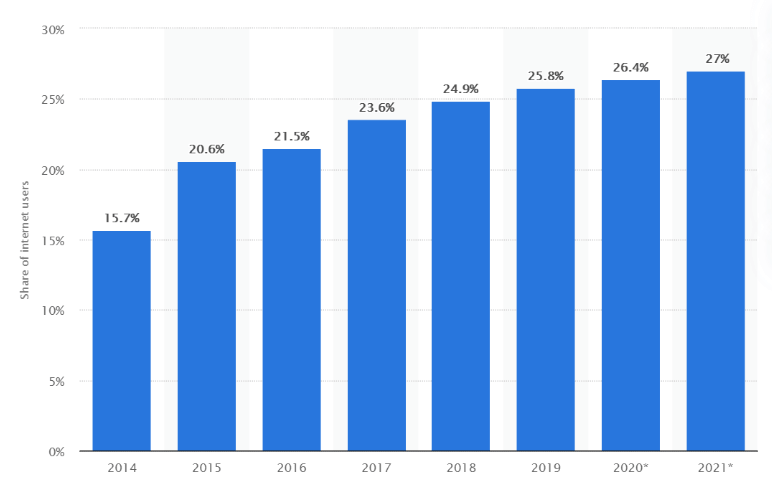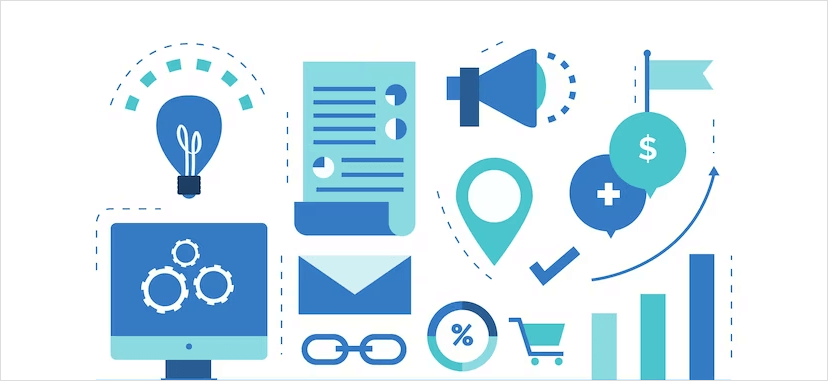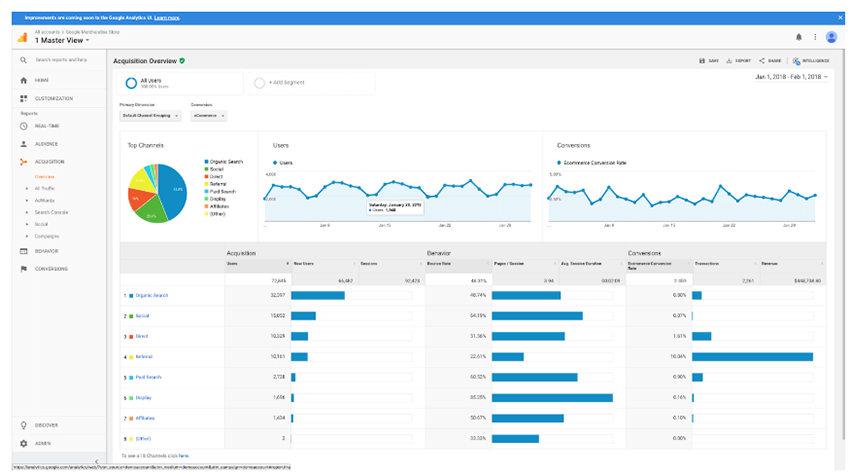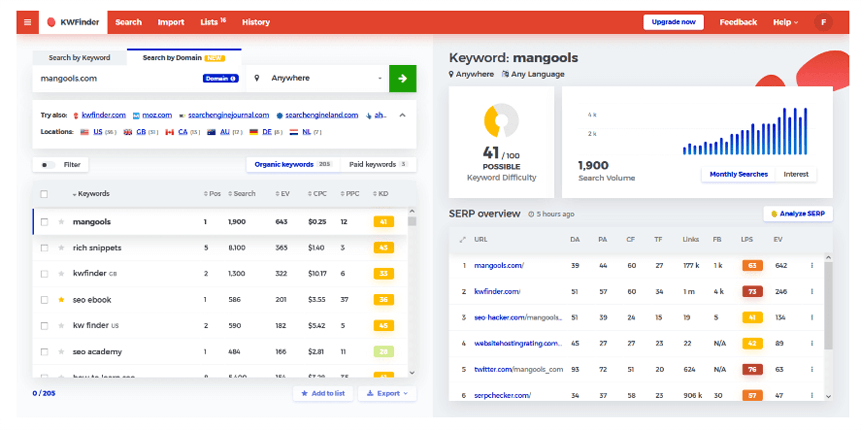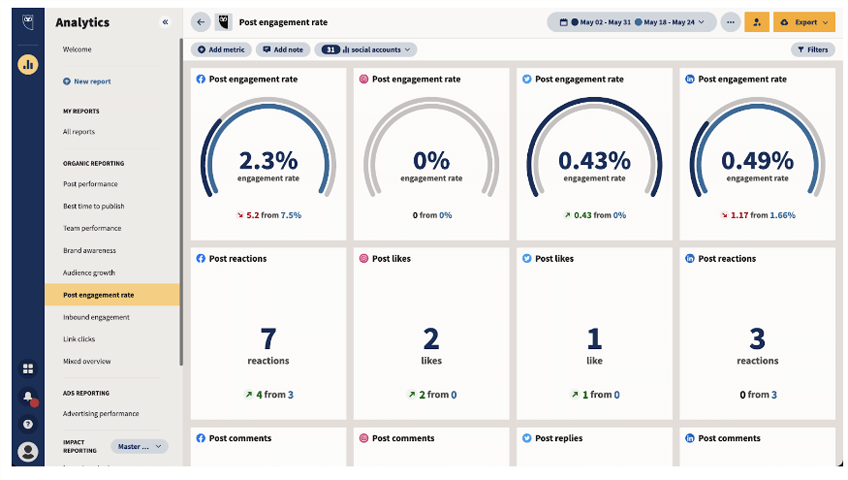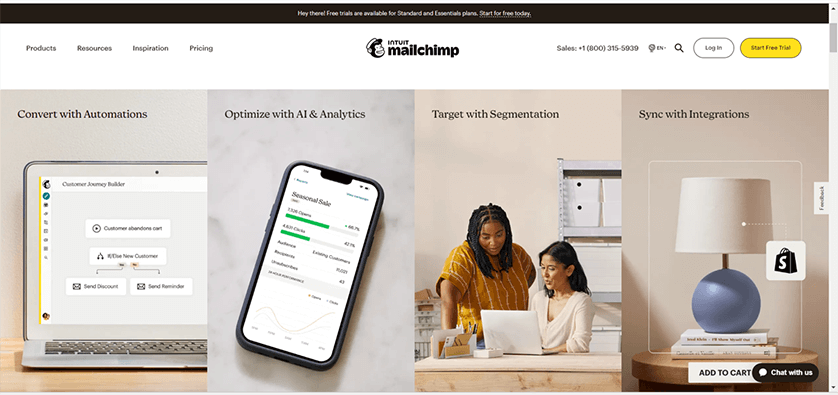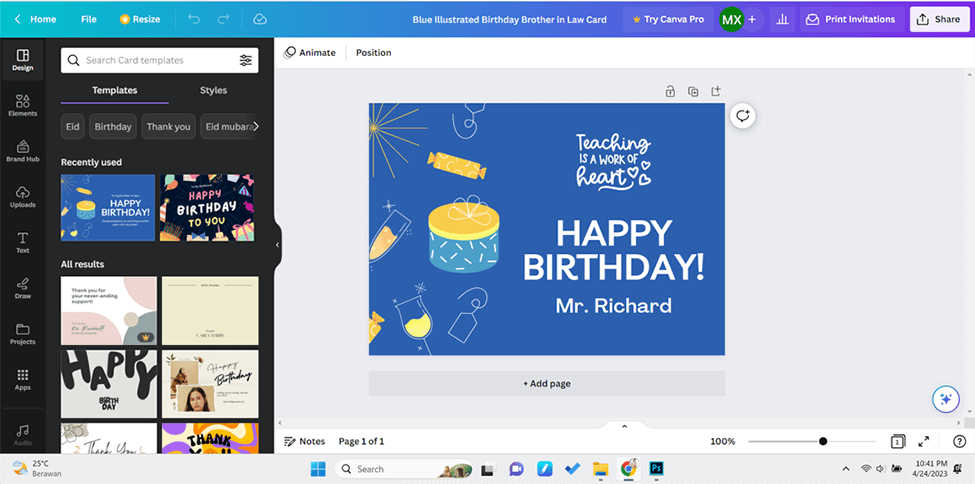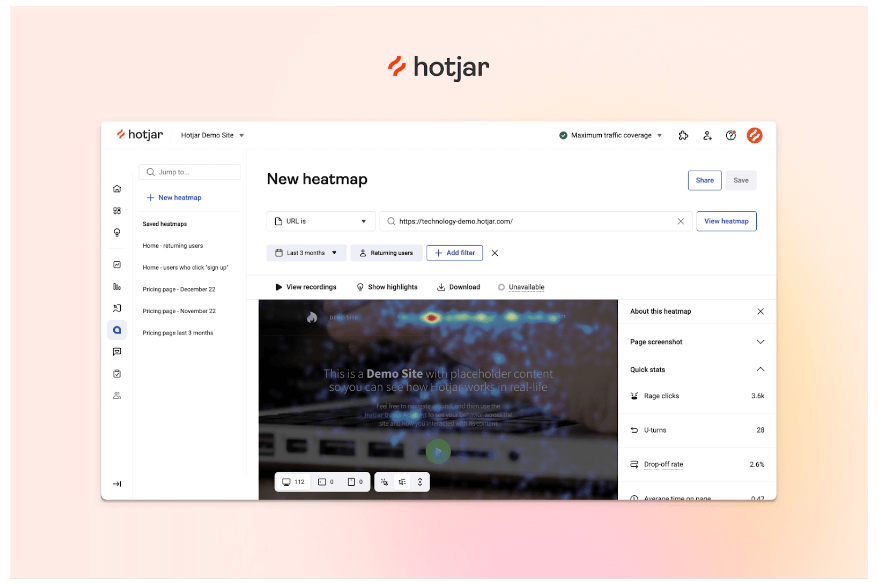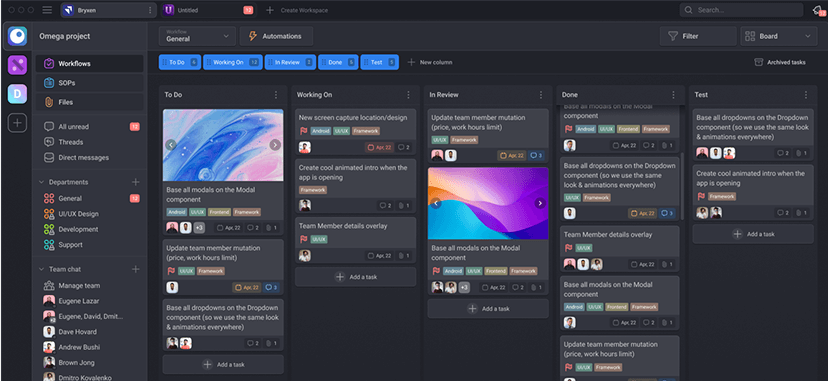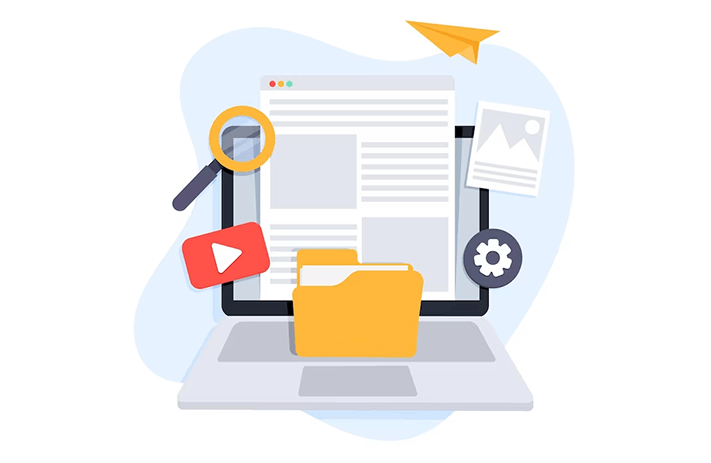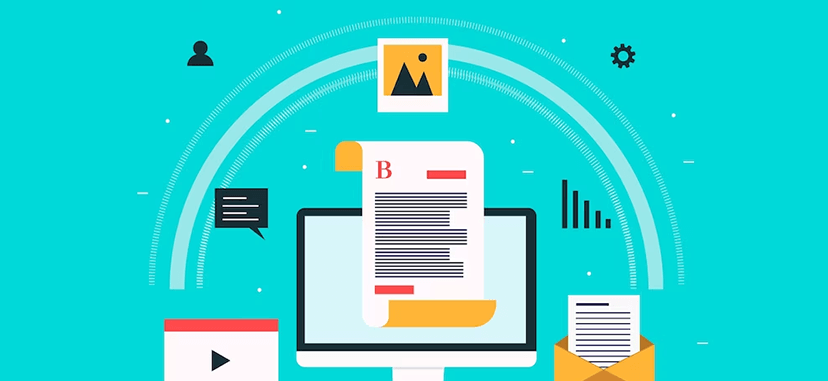Envision this scenario: You’re a construction project manager, juggling multiple tasks like a circus performer. You’ve got deadlines to meet, budgets to balance, and a communication nightmare on your hands.
Suddenly, you remember hearing about a magical solution called construction project management software. With bated breath, you decide to give it a try, and poof – your construction project circus is transformed into a well-oiled machine.
Okay, maybe it’s not that magical, but construction project management software can certainly make your life easier, boost efficiency, and lead to greater project success.
But wait, there’s more! (We couldn’t resist a classic infomercial line.)
We’ll also dive into the key features, benefits, and factors to consider when choosing the best construction project management software for your company.
So, grab a hard hat, put on your best tool belt, and join us as we break ground on this comprehensive guide to the best construction project management software solutions available today.
Who knows, by the end of this article, you might even be ready to swap your trusty clipboard for a shiny new software system!

Understanding Construction Project Management Software
Before we dive headfirst into our list of top construction project management software solutions, it’s essential to understand what these powerful tools are all about.
In this section, we’ll discuss what construction project management software is, the key features you should look for, and the benefits it can bring to your construction projects.
So, let’s lay the foundation for our journey into the world of construction software, shall we?
What is construction project management software?
Construction project management software is a digital tool designed to help construction professionals plan, execute, and control every aspect of their projects more efficiently.
It centralizes all project-related information in one accessible platform, streamlining processes and communication across the team.
Whether you’re building a single-family home or a skyscraper, the right construction project management software can make your life significantly easier and your projects more successful.
Key features of construction project management software
To make the most of your construction project management software, you’ll want to familiarize yourself with some of the essential features that can take your projects from “meh” to “marvelous.” In this section, we’ll go over the four key features that every top-notch construction software should offer:
Scheduling
A construction project without a schedule is like a ship without a compass. The scheduling feature in construction project management software allows you to create and maintain detailed project timelines, assign tasks, set deadlines, and monitor progress.
Say goodbye to sticky notes and wall calendars – scheduling software will keep your project on track and help you spot potential delays before they become major headaches.
Budgeting
Budgeting is a critical aspect of any construction project, and having the right tools to manage your finances can be a game-changer. Construction project management software often includes budgeting features that help you create cost estimates, track expenses, and monitor your project’s financial health. This way, you can keep your finger on the pulse of your budget and ensure that you’re spending wisely.
Document management
Construction projects generate a mountain of paperwork, from contracts and permits to blueprints and change orders. With document management features, construction project management software allows you to store, organize, and access all your essential documents in one centralized location. Plus, you can easily share them with your team members, making collaboration a breeze.
Collaboration and communication
The secret sauce for any successful construction project is clear communication and collaboration among all stakeholders. Construction project management software offers a variety of tools to facilitate communication, including messaging, file sharing, and real-time updates. This ensures that everyone is on the same page, reducing the risk of miscommunication and costly errors.
Benefits of using construction project management software
By now, you’re probably starting to see the value of construction project management software. But just in case you’re not completely sold, let’s explore some of the top benefits that this powerful tool can bring to your construction projects …
Time savings
We all know that time is money, especially in the construction industry. Construction project management software can save you and your team precious hours by automating repetitive tasks, streamlining workflows, and providing real-time information. This means less time spent chasing down updates and more time focusing on the work that matters.
Improved communication and collaboration
Construction project management software breaks down the barriers between team members, ensuring that everyone has access to the information they need, when they need it. With better communication and collaboration, your team can work together more effectively, which can lead to fewer errors, faster project completion, and happier clients.
Reduced errors and rework
Mistakes can be costly in the construction industry, but construction project management software can help you minimize errors by providing real-time information, maintaining accurate records, and streamlining communication.
When everyone on the team is working with the most up-to-date information, there’s less risk of costly miscommunication or misunderstandings. Plus, with all your essential documents stored and organized in one place, you can say goodbye to the days of misplaced blueprints and lost change orders.
Better project tracking
Keeping tabs on the progress of your construction project can be a daunting task, but construction project management software makes it easy. With robust tracking features, you can monitor the status of tasks, budgets, and resources in real time. This allows you to identify potential issues early on and make informed decisions to keep your project on track and within budget.
Now that we’ve laid the groundwork for understanding construction project management software, it’s time to explore the top solutions available on the market.
In the following sections, we’ll dive into the best free options, software for small businesses, and the overall top choices for construction project management software. So, strap on your tool belt and let’s get to work!

Top 5 Free Construction Project Management Software
Everyone loves a good bargain, especially when it comes to tools that can improve your construction projects. In this section, we’ll explore the world of free construction project management software, comparing key features, pros, and cons. By the end, you’ll be armed with the knowledge you need to choose the best free software solution for your needs. So, let’s dive in!
Overview of free construction project management software options
Free construction project management software can be a great option for businesses on a tight budget or those looking to test the waters before committing to a paid solution.
While these options may not offer all the bells and whistles of their paid counterparts, they can still provide valuable tools to help you manage your projects more effectively.
Comparison of key features, pros, and cons
When evaluating free construction project management software, it’s essential to consider the features, pros, and cons of each option. While some software may excel in one area, it might fall short in another. Keep your specific needs and priorities in mind as you compare the different options.
Analysis of the top 5 free software solutions
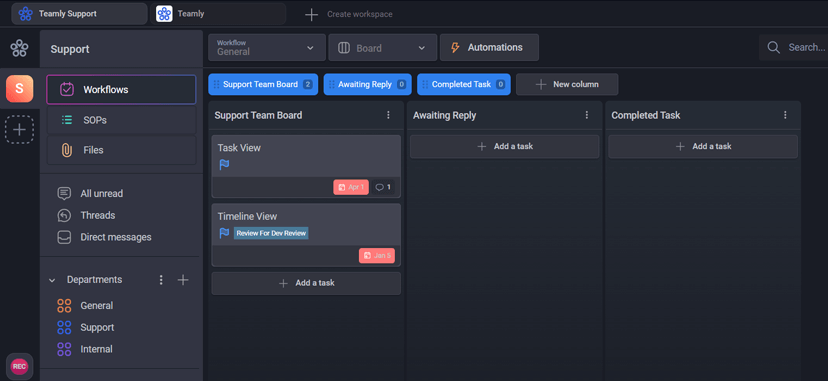
Free Software Solution #1: Teamly
Teamly is our versatile remote team management solution that’s incredibly easy to use and adapts to various industries, including construction companies. With Teamly, you can efficiently manage projects, assign tasks, store documents, and track progress to ensure that jobs are completed on time.
The platform offers a wide range of powerful features that streamline communication and collaboration, making Teamly an ideal choice for small businesses looking to optimize their construction projects and achieve greater success.
Teamly benefits:
- Intuitive interface that’s easy to use and requires minimal onboarding time
- Free version allows unlimited users & unlimited tasks
- Comprehensive feature set, including real-time chat, workflow management, screen capture recording, time tracking, and payroll
- Ability to view labor costs in real-time
Pros:
- Affordable pricing structure
- Generous free version
- Excellent customer support
- Regular software updates
Cons:
- Limited advanced features compared to some enterprise-level solutions
- May not be suitable for very large-scale projects
Summary: Teamly’s adaptability, ease of use, and comprehensive suite of features make it a valuable tool for construction teams looking to improve collaboration and streamline project management processes. With Teamly, your team can stay connected, keep projects on track, and achieve even greater success in the construction industry.
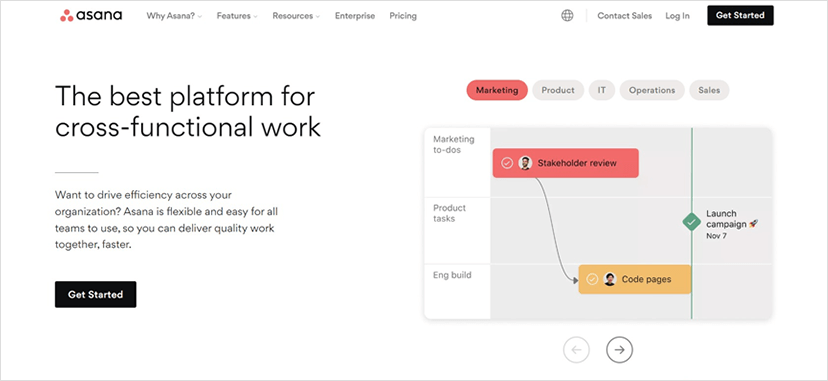
Free Software Solution #2: Asana
Asana is a versatile project management software that can be adapted for use in construction projects. With its powerful task management, scheduling, and collaboration tools, Asana can help construction teams stay organized and ensure projects are completed on time and within budget.
Pros:
- Easily adaptable for construction project workflows
- Robust task management and scheduling features
- Effective team collaboration tools, including real-time updates and communication channels
- Integrations with popular construction software and tools
Cons:
- Not specifically designed for the construction industry, so it may lack some specialized features
- The free version limits available features and caps team size at 15 members
Summary: Though Asana is not specifically tailored to the construction industry, its flexibility and adaptability make it a useful tool for construction teams in need of a free project management solution.
By leveraging Asana’s robust task management, scheduling, and collaboration features, construction teams can efficiently manage their projects and maintain clear communication throughout the project lifecycle.
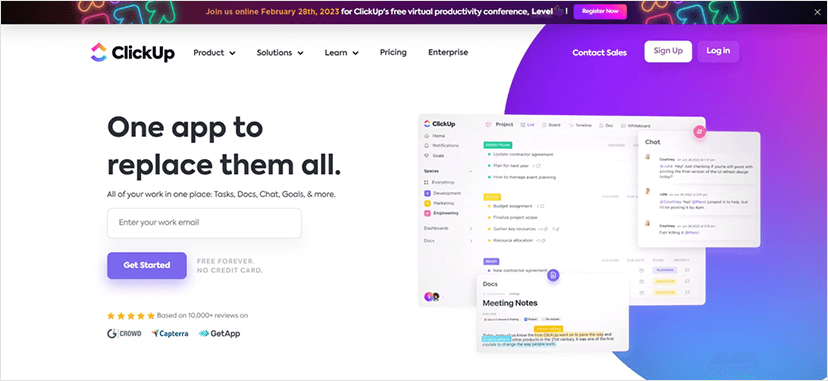
Free Software Solution #3: ClickUp
ClickUp is a comprehensive project management software with a highly customizable interface that can be tailored to fit the needs of construction teams. Its wide range of features, including task management, scheduling, and time tracking, can help construction teams stay organized and ensure projects run smoothly from start to finish.
Pros:
- Highly customizable interface, suitable for construction teams
- Wide range of features, such as task management, scheduling, and time tracking
- Easy-to-navigate, user-friendly platform
- Regular software updates and active development
Cons:
- Not specifically designed for the construction industry, so some specialized features may be lacking
- Free version has limitations on storage and some advanced features
Summary: ClickUp offers a customizable and feature-rich project management solution that can be tailored to suit the needs of construction teams. Although it’s not specifically designed for the construction industry, its extensive range of features and user-friendly interface make it a good choice for construction teams seeking a free project management software.
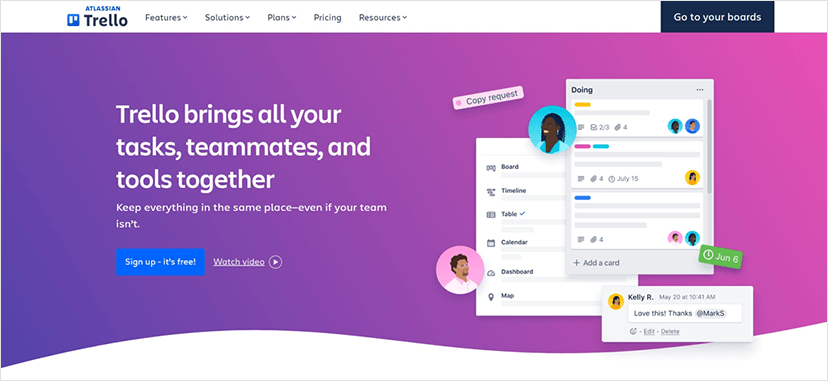
Free Software Solution #4: Trello
Trello is a popular, free project management software known for its simplicity and visually appealing design. Though not specifically tailored for the construction industry, Trello’s flexible Kanban boards and cards can be easily adapted to meet the needs of construction project management.
Pros:
- Simple, intuitive design with drag-and-drop functionality
- Visually appealing boards and cards system for organizing tasks
- Mobile app available for on-the-go access, making it convenient for construction site updates
- Integration with various third-party apps to extend its capabilities
Cons:
- Not specifically designed for the construction industry
- Lacks native budgeting tools
- May not be suitable for complex projects with multiple stakeholders and dependencies
Summary: Trello’s simplicity and adaptability make it a useful tool for construction teams looking for a free, easy-to-use project management solution. By customizing boards and cards to fit the specific needs of construction projects, teams can efficiently manage tasks, track progress, and collaborate with ease.
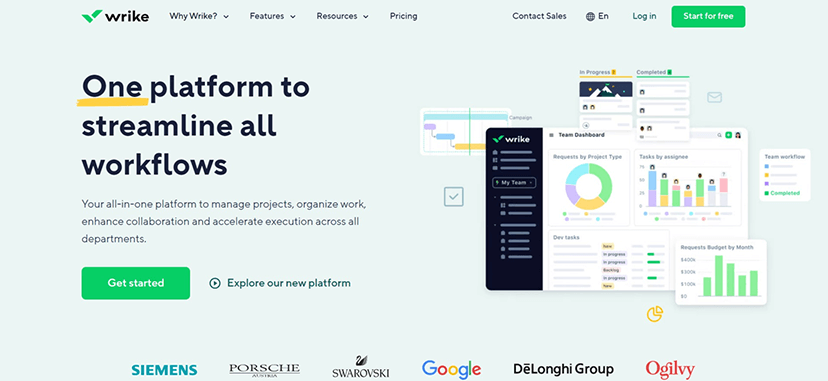
Free Software Solution # 5: Wrike
Wrike is a versatile project management software that offers a free version suitable for construction teams. Although it’s not specifically designed for the construction industry, Wrike’s free plan includes essential features such as task management, subtask management, customizable work views, and email integration.
Pros:
- Core project management features available in the free version
- Customizable work views, including Table view and Kanban
- Email integration and notifications for seamless communication
- Mobile app for on-the-go access
Cons:
- Lacks resource management and advanced resource capacity planning in the free version
- Not specifically tailored for the construction industry
- Advanced features available only in paid plans
Summary: Wrike’s free version, despite some limitations, offers valuable features for construction teams working on a tight budget. Its task management and collaboration capabilities, along with the option to upgrade for more advanced features, make Wrike a viable option for teams seeking a flexible and adaptable project management solution.
In conclusion, free construction project management software can provide valuable tools and resources for businesses on a budget or those looking to test out software before committing to a paid solution.
As you evaluate the top 5 free options outlined above, keep in mind your project’s specific needs and priorities. By doing so, you’ll be able to choose the best free software solution for your construction projects.
While free construction project management software can be a great starting point, it’s also essential to consider the benefits of investing in a paid solution, especially if your projects are more complex or if your business is growing.
In the next section, we’ll explore the top 5 construction project management software options for small businesses. These paid construction PM tools offer more advanced features and support to help you take your projects to the next level.

Top 5 Construction Project Management Software for Small Businesses
Small businesses often face unique challenges when it comes to managing construction projects, making it essential to find software solutions tailored to their needs.
In this section, we’ll explore the top 5 construction project management software options for small businesses. We’ll discuss key features, pros and cons, as well as provide a detailed analysis of each software solution.
Let’s dive into the top choices that can help your small business succeed in the construction industry!
Overview of small business-specific construction project management software
Small business-specific construction project management software is designed to cater to the unique needs and challenges faced by smaller companies. These solutions often prioritize affordability, ease of use, and scalability to ensure that they can grow with your business.
By choosing a software solution tailored to your small business, you can maximize your investment and streamline your construction project management process.
Comparison of key features, pros, and cons
When evaluating construction project management software for small businesses, it’s crucial to consider the features, pros, and cons of each option. Look for software solutions that offer the tools and resources you need to manage your projects effectively, without breaking the bank or overwhelming your team with complex interfaces.
Detailed analysis of the top 5 software solutions for small businesses
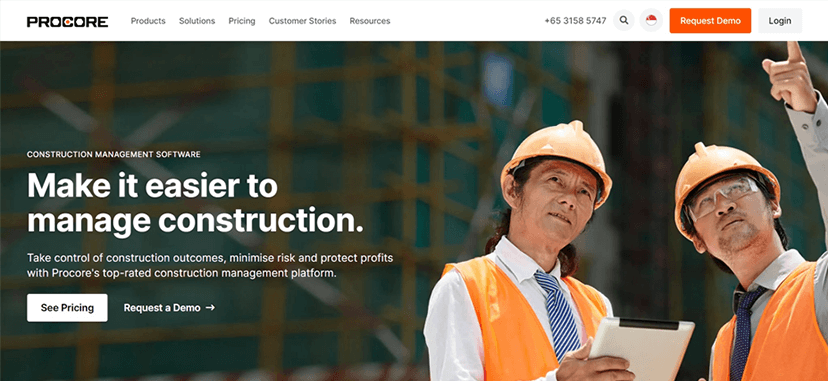
Software Solution for Small Businesses #1: Procore
Procore is a comprehensive and popular construction project management software designed to streamline every aspect of a construction project, from design to closeout. Its robust set of features makes it an excellent choice for small businesses that are looking for an all-in-one solution.
Pros:
- Comprehensive feature set, including document management, budgeting, scheduling, and more
- User-friendly interface with a short learning curve
- Integration with popular tools like QuickBooks and AutoCAD
- Scalable solution that can grow with your business
Cons:
- Relatively expensive compared to other options on this list
- Can be overwhelming for first-time users due to its extensive functionality
Summary: Procore is a powerful and versatile construction project management software, ideal for small businesses looking for a comprehensive solution. While it may be more expensive than other options, its robust functionality and scalability make it a worthy investment.
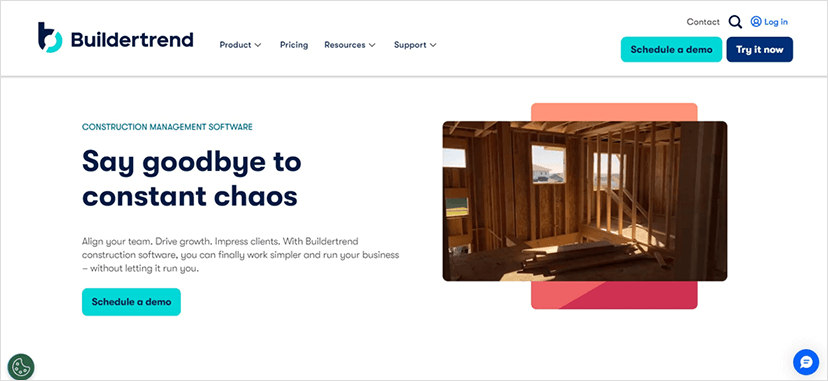
Software Solution for Small Businesses #2: Buildertrend
Buildertrend is a cloud-based construction project management software that’s geared toward residential construction. With features tailored to the needs of home builders, remodelers, and contractors, Buildertrend offers an excellent solution for small businesses in this niche.
Pros:
- Designed specifically for residential construction projects
- User-friendly interface and easy setup
- Great collaboration and communication tools for both internal teams and clients
- Integrates with popular software like QuickBooks and Xero
Cons:
- Limited applicability for commercial construction projects
- Some users may find the mobile app less intuitive than the desktop version
Summary: Buildertrend is a top choice for small businesses in the residential construction industry due to its tailored features, user-friendly design, and excellent collaboration tools. However, it may be less suitable for commercial construction projects.
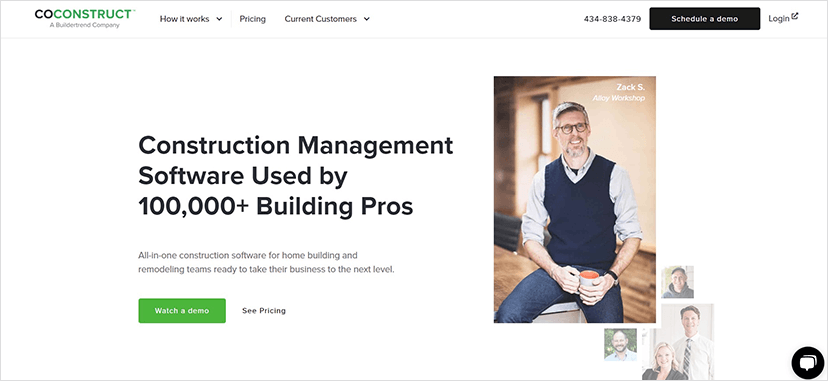
Software Solution for Small Businesses #3: CoConstruct
CoConstruct is a construction project management software that offers an all-in-one platform for managing projects, clients, and teams. It’s tailored specifically for custom home builders and remodelers, making CoConstruct a great choice for small businesses in these sectors.
Pros:
- Customizable to fit the needs of home builders and remodelers
- Offers client management features for enhanced communication and collaboration
- User-friendly interface and mobile app
- Integrates with popular accounting tools
Cons:
- Limited suitability for large-scale or commercial construction projects
- Some users may find the learning curve steep at first
Summary: CoConstruct is an ideal choice for small businesses in the custom home building and remodeling sectors, as it offers a tailored solution for their specific needs. Its excellent client management features and integration with popular accounting tools make it a solid option for these types of businesses.
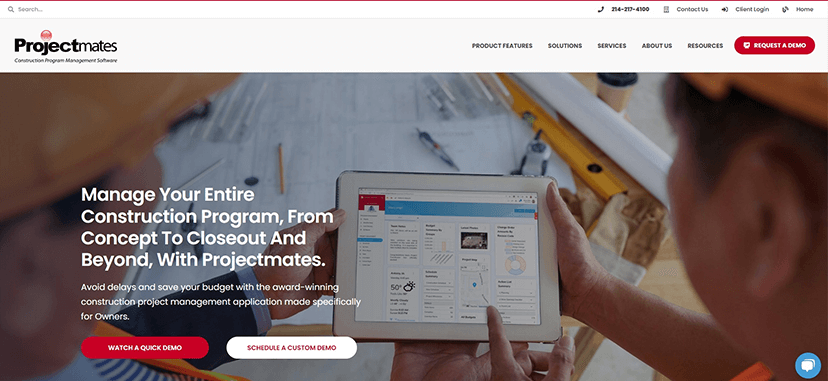
Software Solution for Small Businesses #4: Projectmates
Projectmates is a comprehensive construction project management software platform that streamlines collaboration and efficiency with its robust features, including document management, scheduling, and budgeting. Specifically designed for the construction industry, it caters to the unique needs of small businesses, making project management and communication seamless for all stakeholders.
Pros:
- Comprehensive feature set for construction project management
- User-friendly interface with customizable dashboards
- Mobile app for on-the-go access
- Excellent customer support
Cons:
- Pricing may be a barrier for some small businesses
- Some users may find the software complex to set up
Summary: Projectmates is a well-rounded construction project management software with a user-friendly interface and customizable dashboards. Its comprehensive feature set makes it a strong choice for small businesses, although pricing may be a barrier for some.
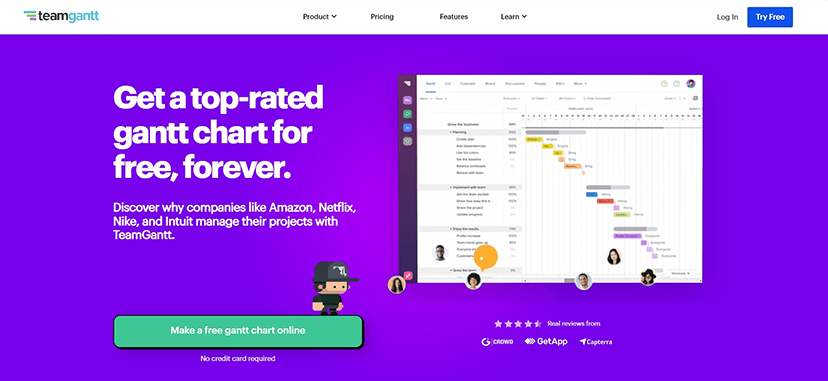
Software Solution for Small Businesses #5: TeamGantt
TeamGantt is a web-based project management software that specializes in providing an intuitive and visually appealing Gantt chart interface for construction teams. Its focus on visual project planning, timeline management, and resource allocation makes it an ideal choice for small businesses.
Pros:
- Visually appealing and easy-to-use Gantt chart interface
- Efficient project timeline and resource management
- Collaborative features like task commenting and file attachments
- Integrates with popular tools like Trello, Slack, and Zapier
Cons:
- Lacks some advanced construction-specific features found in other solutions
- The free version has limited functionality and user capacity
Summary: TeamGantt is a great choice for small businesses looking for an easy-to-use, visually appealing project management tool that emphasizes timeline management and resource allocation. While it may not offer all the advanced construction-specific features found in other solutions, its seamless integrations and collaborative tools make it a solid choice for small construction teams.
In conclusion, small businesses in the construction industry can benefit greatly from choosing a project management software solution tailored to their unique needs. By evaluating the top 5 options outlined above, you can select the software that offers the right balance of features, affordability, and ease of use to help your small business succeed.
As you continue to grow and expand your construction business, you may also want to consider exploring more advanced software solutions that can help you manage larger and more complex projects.
In the next section, we’ll take a look at the overall top 5 construction project management software options on the market, which can provide even more advanced features and capabilities to help your business reach new heights.

Top 5 Best Overall Construction Project Management Software (including paid options)
In this section, we’ll explore the top 5 best overall construction project management software solutions, including both free and paid options. We’ll provide an overview of the best software, compare key features, pros, and cons, and analyze the top 5 software solutions to help you make an informed decision.
Overview of the best overall construction project management software
The best overall construction project management software solutions provide a comprehensive set of tools and features to help businesses of all sizes manage their construction projects more effectively.
These solutions often prioritize ease of use, scalability, and integration with other software platforms to ensure they can meet the needs of various businesses in the construction industry.
Comparison of key features, pros, and cons
When evaluating the best overall construction project management software, it’s essential to consider the features, pros, and cons of each option. Look for software solutions that offer the tools and resources you need to manage your projects effectively while also providing excellent customer support and integration with other essential tools.
Detailed analysis of the top 5 best overall software solutions

Best Overall Software Solution #1: Procore
As previously mentioned, Procore is a leading construction project management software that offers a comprehensive set of tools for small businesses, making it one of the best overall solutions in the market. Its wide range of features, including project management, financials, quality and safety, and field productivity, ensures that all aspects of construction projects are covered.
Pros:
- Extensive feature set tailored for the construction industry
- User-friendly interface and easy collaboration
- Strong integration capabilities with other software
- Regular updates and improvements
- Excellent customer support
Cons:
- Pricing can be expensive for smaller businesses
- Some users may experience a learning curve
Summary: Procore is an industry-leading construction project management software with an extensive range of features and strong integration capabilities. While its pricing may be a barrier for smaller businesses, its comprehensive toolset makes it an excellent choice for larger construction companies seeking an all-in-one solution.
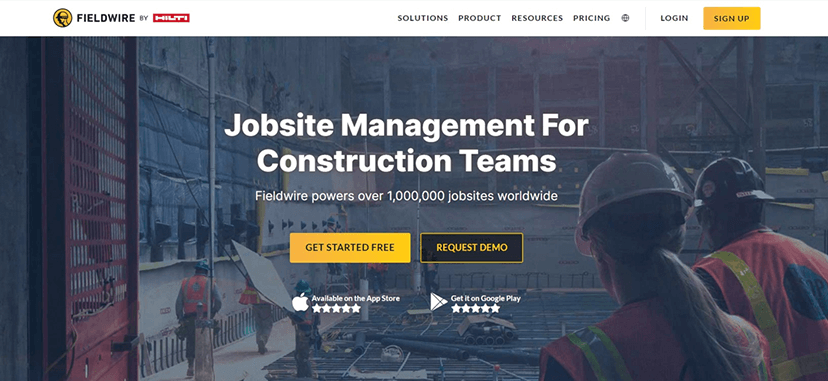
Best Overall Software Solution #2: Fieldwire
Fieldwire is a powerful construction project management software that excels in coordination and collaboration, making it an essential tool for teams looking to streamline their projects. With a focus on mobile-first functionality, Fieldwire ensures that everyone on the team has access to real-time project data, even when they’re on the go.
Pros:
- Exceptional coordination and collaboration tools for field and office teams
- Mobile-first approach with seamless switching between desktop and mobile
- Real-time access to project data
- Highly customizable to suit the needs of any project
Cons:
- May have a learning curve for users new to construction project management software
- Some users may find the interface less visually appealing than competitors
Summary: Fieldwire stands out as a top choice for teams that prioritize coordination and collaboration in their construction project management. With its mobile-first design and real-time access to project data, Fieldwire helps keep everyone connected and informed, ensuring a smoother project execution from start to finish.
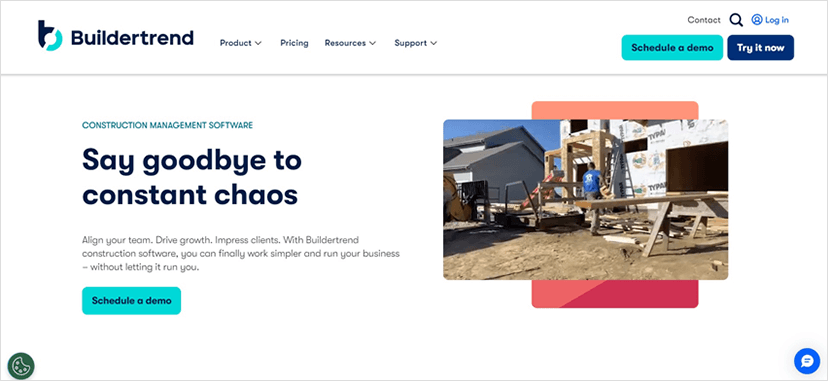
Best Overall Software Solution #3: Buildertrend
Buildertrend, a top choice for small businesses, is also a powerful overall construction project management software. It offers an extensive range of features, including project management, customer relationship management (CRM), and financial tools, making it a great all-around solution for construction companies of all sizes.
Pros:
- Comprehensive feature set for construction project management
- Customizable dashboards and templates
- Strong customer support and onboarding resources
- Integration with popular software and tools
Cons:
- Pricing may be expensive for smaller businesses
- Some users may experience a learning curve
Summary: Buildertrend is a versatile construction project management software with a comprehensive feature set that caters to companies of all sizes. Although pricing may be a barrier for some smaller businesses, its robust tools and excellent customer support make it a top choice in the industry.
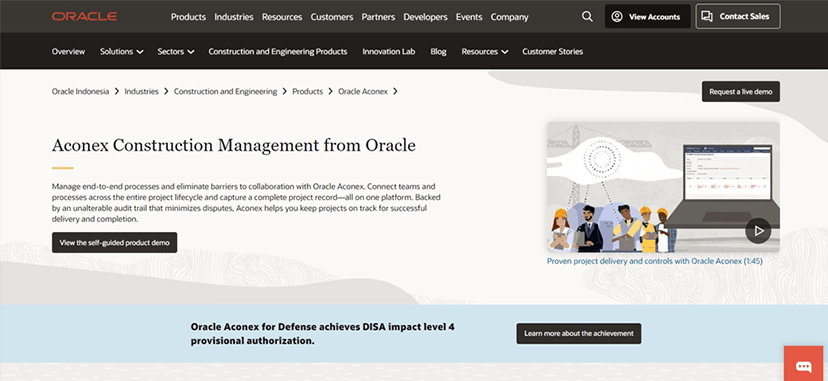
Best Overall Software Solution #4: Oracle Aconex
Oracle Aconex is a cloud-based construction project management software that provides powerful tools for managing documents, processes, and project information. It aims to streamline collaboration and reduce risk across construction projects.
Pros:
- Secure and reliable platform for managing project information
- Wide range of features for document and process management
- Strong integration capabilities with other Oracle products
- Excellent customer support and regular updates
Cons:
- Can be complex and may have a steep learning curve
- Pricing may be a barrier for some businesses
Summary: Oracle Aconex is a powerful construction project management software that focuses on document and process management. While it can be complex and may have a steep learning curve, its strong integration capabilities and reliable platform make it a solid choice for larger construction projects.

Best Overall Software Solution #5: CoConstruct
CoConstruct is an all-in-one construction project management software that caters to custom home builders and remodelers. As previously identified, it’s a top solution for small businesses seeking a comprehensive project management software, but it also stands out as one of the best overall solutions in the industry.
Pros:
- Extensive feature set for project management, financials, and client management
- Customizable features and templates for building project plans
- Excellent communication tools for client management
- Integrations with popular construction software and tools
Cons:
- Pricing may be expensive for smaller businesses
- Some users may experience a learning curve
Summary: CoConstruct’s comprehensive all-in-one solution, customizable features, and excellent communication tools make it a top choice for custom home builders and remodelers. It stands out as one of the best overall solutions in the industry, but pricing may be a barrier for smaller businesses.
In conclusion, the best overall construction project management software options cater to the unique needs of businesses of all sizes in the construction industry.
By carefully evaluating the top 5 solutions outlined above, you can select the software that offers the right balance of features, affordability, and ease of use to help your business succeed.
Whether you’re a small business looking to streamline your construction project management process or a large enterprise seeking to improve efficiency and collaboration, there’s a software solution out there to meet your specific needs.

How to Choose the Right Construction Project Management Software
Selecting the right construction project management software can significantly impact your business’s success and efficiency. In this section, we’ll discuss some essential factors to consider when choosing the software that best fits your needs.
Identifying your project’s specific needs
Before evaluating software options, take the time to identify your project’s specific needs. Consider factors such as the size and complexity of your projects, the number of team members involved, and your primary goals for using project management software. This will help you narrow down the features that are most important to you.
Evaluating features and pricing options
Once you have a clear understanding of your project’s needs, compare the features and pricing options of different construction project management software solutions. Look for a solution that offers the tools and resources you need to manage your projects effectively while also fitting within your budget.
Considering scalability and integration with existing tools
When selecting construction project management software, consider how the solution will grow with your business. Choose a scalable software solution that can accommodate your expanding project portfolio and team size.
Additionally, look for software that integrates with your existing tools and platforms, such as accounting software, file storage systems, and communication tools. This will help streamline your workflows and increase efficiency.
The importance of user-friendly interfaces and support
A user-friendly interface is critical for ensuring your team can quickly learn and adopt the new software. Look for solutions that prioritize ease of use and offer training resources and customer support to help your team get up to speed.
The faster your team can adapt to the new software, the more efficient and successful your construction project management process will be.
Conclusion
We’ve discussed various construction project management software solutions in this article, including free options, solutions designed for small businesses, and the best overall choices. These software options can help you streamline your construction projects, improve collaboration, and ultimately drive success in your business.
Now that you’re armed with knowledge about the top construction project management software options, it’s time to take action. Evaluate your project’s specific needs and consider the factors discussed in this article to help you select the perfect solution for your business. By choosing the right software, you’ll be well on your way to more efficient and successful construction project management.
As you explore your options, we encourage you to give Teamly a try. Teamly is designed with small businesses in mind and offers a wide range of features, a user-friendly interface, and excellent customer support. With Teamly, you’ll gain access to the tools and resources you need to manage your construction projects more effectively.
Don’t just take our word for it – experience Teamly’s benefits for yourself. Sign up for a free Teamly account today and discover how Teamly can help you take your construction project management to the next level.























